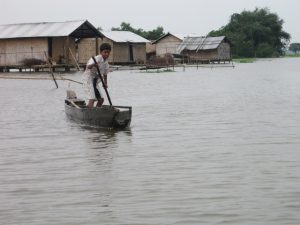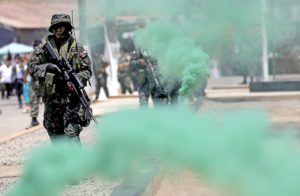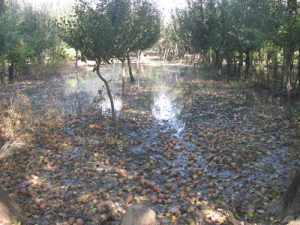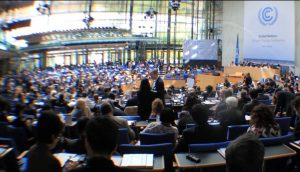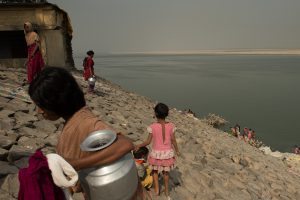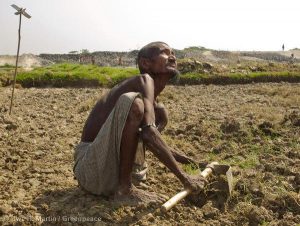Editor’s note: The two devastating earthquakes and hundreds of aftershocks that struck Nepal in the last month have increased the risks of massive landslides in the Koshi basin, which could block river channels and cause flash floods downstream.
The tributaries of the Koshi river originate in Sindhupalchowk and Dolakha – the districts worst hit by the earthquake. Last year a large landslide in Sindhupalchowk district blocked the Sunkoshi river — a major tributary of the Koshi — killing 150 people and threatening downstream India.
The earthquake has raised fresh concerns about building large dams in the earthquake prone Himalayan region.
It’s mid-morning and Chandra Rai is chiselling and sawing wooden planks by the Koshi River in Ahale village, Dhankuta district of south-eastern Nepal. The farmer, who lives with his wife and mother, is building a bamboo house by the bank of the river.
People from all walks of life walk past him along the narrow mountain trail: Porters carrying loads weighing up to 60 kilogrammes, toddlers perched on their parents’ shoulders, young men and women with backpacks. As the mighty Koshi River roars past it brings life to this picturesque but poverty-stricken place. And Rai, whose home and a small plot of land is higher up the mountains, has counted on this bamboo structure to make a small fortune.
Once completed, the 70,000-Rupee ($700) bamboo structure will be a grocery store. The centuries-old mountain trail once served as the main artery connecting Nepal’s five hill districts to the vast southern plains, but now it only sees a trickle of travellers, thanks to an unprecedented drive to build roads in the country’s rural hills.
Rai, however, is unfazed by such transformation. “Subsistence farmers like us could not earn much despite working hard. Our family grew larger while our farmland remained the same,” Rai says.
After draining its three tributaries, a few miles upstream in Triveni the river becomes the Sapta Koshi, Nepal’s largest river, before flowing through the plains into India and merging with the Ganga.
Passing through diverse landscapes, climates and lifestyles, the Sapta Koshi sustains tens of thousands of mountain communities in Nepal.
But everything that the villagers hold dear will be threatened if Indian and Nepali politicians are allowed to prevail with their plan to tame the river.
An ambitious multi-purpose dam has been proposed in Sunakhambi, two kilometres upstream from Barah Kshetra, one of the holiest pilgrimage places for Hindus. The dam will stand 269-metres high and generate 3,300 MW of hydroelectricity.
If the Sapta Koshi High Dam goes ahead, it will displace an estimated 75,000 people living in over 80 villages seven districts.
While government officials never tire of talking about the benefits—half a million hectares of irrigated farmland in Nepal and more than double that in India, as well as improved navigation along the river—the real purpose of the Sapta Koshi High Dam is to control the annual monsoon floods downstream in the Indian state of Bihar.
Opinion is divided over whether a high dam in the Himalayan foothills can save India from floods, or whether it is better to build embankments along the river banks.
Grassroots protests
The decades-old idea of the Sapta Koshi High Dam was revived after the Nepalese Prime Minister Girija Prasad Koirala visited India in 1991 and agreed to launch a joint investigation to assess the project.
Work only began in earnest in August 2004 when a joint office was set up in Biratnagar, southern Nepal, tasked with preparing a detailed report on the environmental and socio-economic impacts of the project.
But a long standing grassroots protest movement has stymied any progress on the project to date. Over the years, people who will be affected by the project have formed struggle committees, staged protests against the plan and in July 2005, participated in the meeting of water experts in Itahari, which they say, helped them understand the issue of water rights better.
On January 17 2015, hundreds of villagers gathered under the shade of the Baraha Kshetra Temple complex to protest, demanding the assessment work be halted immediately. A week later, drilling at the dam site came to a stop. In July last year, the locals had organised similar protests, demanding that the government raise the issue during the visit of Indian Prime Minister Narendra Modi to Nepal.
The villagers, mostly farmers, have coalesced around Ganesh Bahadur Rai, a chain-smoking septuagenarian. They have organised themselves under the banner of Saptakoshi Jana Adhikar Manch (Sapta Koshi People’s Rights Forum), which has around 5,000 members in nine districts.
The signs of protests are everywhere: “ILO 169” is painted on rocks along the trail. Their message is loud and clear: the locals want their rights protected under the International Labour Organization declarations. (In 2007, Nepal became the only South Asian country to ratify the UN convention which aims to ensure the rights of indigenous and tribal people to land and resources).
Rai speaks passionately about the battle he’s been waging: “We regard our rivers as our country’s lifelines. This is a national treasure,” he says, adding that the dam dissent doesn’t mean they are against development. “We don’t oppose development, but development at what cost and for whom?”
“We have heard that Nepal will get only 300 MW out of 3,300 MW from the proposed high dam. We are demanding equitable benefit sharing from our water resources. We must have a say on the project. All the information regarding it must be shared with us.”
In the 1950s, New Delhi and Kathmandu signed the Koshi the Gandak agreement, under which India was allowed to construct a barrage and embankments in Nepal and would bear the costs and maintain and control the infrastructure.
Critics argue the treaty was unequal and because most of the benefits from the barrage accrued to India and the government of the bordering Indian state of Bihar responsible for the project, failed to maintain the embankments, which led to the routine breaches and flooding in Nepal.
Indeed, the treaties, signed when Nepal had just emerged from a century of oligarchic Rana rule, provoked political passions, triggering decades of anti-India campaigns that have damaged bilateral relations.
Mistrust clouds the horizon
Such a legacy of mistrust and conflict doesn’t inspire Rai, a retired local cadre of the ruling Unified Marxist-Leninist Party, with optimism for the future.
“We’re determined not to let our leaders commit mistakes again. We want to save the Koshi from such follies,” he says. Rai argues Nepal’s natural resources should be used to benefit its own people rather than handed over to another country.
Bam Prakash Rai, who lives with his family in the nearby Chhintang village in Dhankuta district, echoes the elder villager’s concerns.
“We won’t obstruct the work if our own government builds the dam. But India is doing it and we can’t trust our neighbour,” Bam says. He points to India’s failure to pay compensation it promised to the victims of 1984 flood when the Koshi breached its embankments. Under the Koshi agreement, India is required to compensate flood victims who live within 20 square miles upstream of the barrage.
The villagers are equally angry at their politicians. Most villagers agree the government should resettle them before it starts work on the project, an issue they have raised to their local representatives.
“We pleaded our case with every leader of every political party representing these districts. They assured us that they would raise the issue in Parliament, but then they forgot everything,” Bam Prakash Rai adds. “We’ll lose our homes, forests, gardens, temples and our way of life.”
Dinesh Kumar Ghimire, director general of the department of electricity development in Kathmandu, says the government is seeking an all-party consensus to resolve the issue.
“We’re trying to build trust and persuade the locals through political parties,” he said and adds that the very idea of preparing a detailed project report (DPR) was to assess the local people’s needs and help them resettle. [But] “If they obstruct our work on the DPR, how will we know the impacts of the project on local people’s lives, livelihood and the entire basin?”
People in the hamlet of Simle, however, are far from convinced. With India pushing for the project and the project assessment going ahead, they say their bargaining power will significantly weaken. For the thousands of people living precariously by the Koshi River, therefore, it’s now or never.
A version of this article was first published on My Republica.

